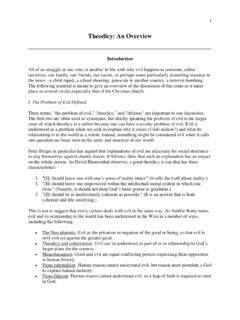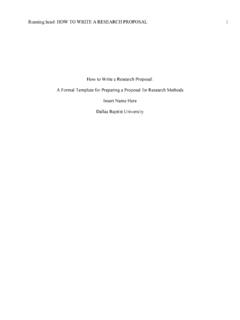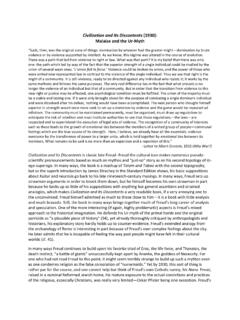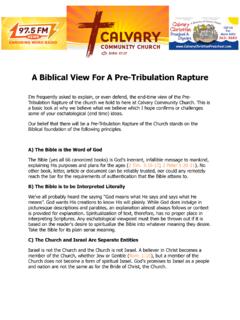Transcription of I. Definition/Description of the Biblical View of the ‘Heart’
1 2001 Summer Institute Dallas Baptist Universityin Christian Scholarship July 11, 2001 The Biblical Conception of the heart I. Definition/Description of the Biblical view of the heart As the image and likeness of God, people are animated subjectively from the core and throughouttheir being by that primary faculty of thought, affection, and will which the Bible calls the heart . As GordonSpykman states, the imago Dei embraces our entire selfhood in all its variegated functions, centered andunified in the heart .
2 1 Similarly, Karl Barth affirms that, the heart is not merely a but the reality of man,both wholly of soul and wholly of body. 2 II. Biblical DataA. Old TestamentUnquestionably, of all the words that are crucial to Biblical anthropology, the word heart is by farthe most important. The term possesses the nuance of centrality since it is used in the Scriptures to referliterally to the inner most part of things, including that of a tree (2 Sam. 18: 14), the sea (Exod. 15: 8; : 2; Jonah 2: 3), the heavens (Deut. 4: 11), and the earth (Matt.)
3 12: 40). In a few texts, heart containsphysiological meaning and designates the actual organ which pumps blood (2 Sam. 18: 14; 2 Kings 9: 24;Psa. 37: 15; Jer. 4: 19), and can be strengthened by food and drink (Gen. 18: 5; Judg. 19: 5, 8; 1 Kings 21:7; Psa. 104: 15; Acts 14: 17; James 5: 5). The preponderance of Biblical passages, however, speak of the heart as the central, definingelement of the human person. In Hebrew, heart (Leb, Lebab) may have been derived from an ancientSemitic root meaning throb which suggests an original pathematic meaning.
4 It occurs approximately 855times in the Old Testament where it stands for all the aspects of a person. 3 In Hebraic thought the heart 1 Gordon J. Spykman, Reformational Theology: A New Paradigm for DoingDogmatics (Grand Rapids, MI: Eerdmans, 1992), Karl Barth, Church Dogmatics, trans., Harold Knight, J. K. S. Reid, R. (Edinburgh: T & T Clark, 1960), III/2, p. Theological Dictionary of the Old Testament, s. v., Leb, Lebab). 2is comprehensive in its operations as the seat of the intellectual ( , Prov.
5 2: 10a; 14: 33; Dan. 10: 12),affective ( , Exod. 4: 14; Psa. 13: 2; Jer. 15: 16), volitional ( , Judg. 5: 15; 1 Chron. 29: 18; Prov. 16:1), and religious life of a human being ( , Deut. 6: 5; 2 Chron. 16: 9; Ezek. 6: 9; 14: 3). Because of thisultimate and vital role, to know a person s heart is to know the actual person. It is the mirror image of aman or woman. As Proverbs 27: 19 puts it, As in water face reflects face, so the heart of man reflectsman. Since the heart holds the key to one s essential makeup, its content and condition must beregularly examined.
6 Watch over your heart with all diligence, admonishes the sage in Proverbs 4: 23, forfrom it flow the springs of life. Thus, while others may take pride in appearance or look outwardly upon thebodily frame, God knows what constitutes a person s essential self, and casts his penetrating gaze uponthe heart (2 Sam. 16: 7; cf. John 7: 24; 8: 15; 2 Cor. 5: 12).B. New TestamentThe New Testament and the teaching of Jesus advance this perspective. The 150 or so uses of heart (kardia) from Matthew to Revelation demonstrate that it is the main organ of psychic and spirituallife, the place in man at which God bears witness to himself.
7 The whole of the inner being of man incontrast to his external side, .. the one center in man to which God turns, in which the religious life isrooted, which determines moral conduct. 4 Indeed, according to various New Testament authors, the heartis the psychic center of human affections (Matt. 22: 37-39; John 14: 1, 27; 2 Cor. 2: 4), the source of thespiritual life (Acts 8: 21; Rom. 2: 29; 2 Cor. 3: 3), and the seat of the intellect and the will (Rom. 1: 21; 2 Cor. 9: 7; Heb. 4: 12). Jesus shares this point of view , teaching that the heart is the spiritual nucleus of theperson about which life orbits.
8 He affirms this anthropological reality in the Sermon on the Mount. ThereJesus offers a warning about earthly and heavenly treasures as contrasting options for a person s basicpursuit in life, the choice of a summum bonum if you will. Terrestrial treasures, he says, are subject tocorruption and theft, whereas celestial treasures possess eternal durability. The choice of either is alldeterminative, and for this reason Jesus associates it with that unifying faculty and hub of life, stating forwhere your treasure is, there your heart will be also (Matt.)
9 6: 19-21; cf. Luke 12: 33-34). Once one s 4 Theological Dictionary of the New Testament, s. v., Kardia. 3treasure is identified, the heart will not be far behind. Neither will a particular way of life. Jesus knew thatthe kind of treasure occupying one s heart will manifest itself in practical ways through patterns of speechand conduct. He also employed a dendrological metaphor to communicate this point. In fact, he uses both trees and treasures in several gospel texts, including this one, to illustrate that out of the heart are theissues of there is no good tree which produces bad fruit, nor, on the other hand, a bad tree whichproduces good fruit.
10 For each tree is known by its own fruit. For men do not gather figs fromthorns, nor do they pick grapes from a briar bush. The good man out of the good treasure of hisheart brings forth what is good; and the evil man out of the evil treasure brings forth what is evil;for his mouth speaks from that which fills his heart (Luke 6: 43-45; cf. Matt. 7: 17-20; 12: 33-35;15: 18-20; Mark 7: 21-23).For Jesus, then, in the heart a treasure resides, out of it fruit is produced, and from it words anddeeds emerge. Regardless of the metaphor he uses (trees or treasures), he was obviously convinced thatthe cornerstone of a human being, the very foundation of a human life, is to be found in the Worldview ImplicationsOn the basis of this anthropological perspective presented in the teachings of Jesus as well as theOld and New Testaments, I would like to offer three suggestions regarding a Biblical approach to worldview.










